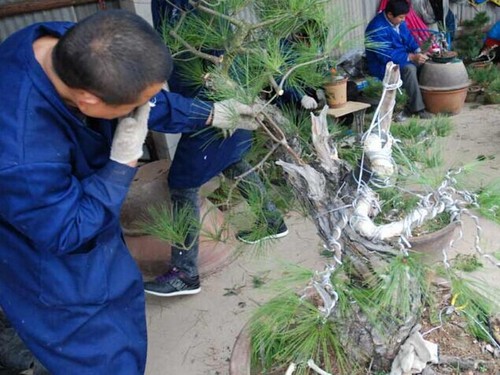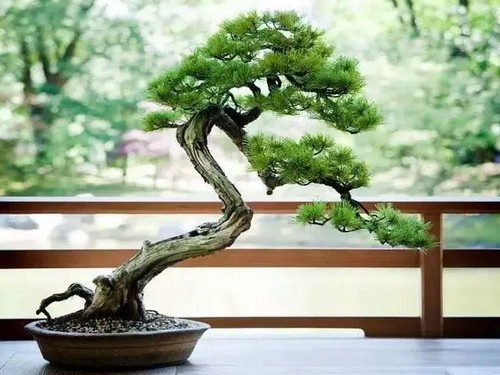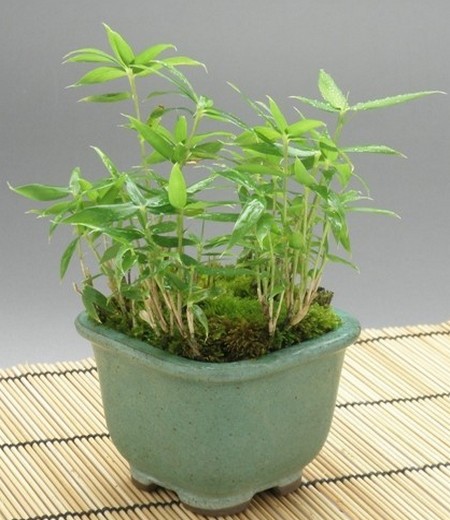Production method and matters needing attention of Masson Pine Bonsai
Pinus massoniana, also known as Pinus massoniana, is a common tree species, but the material that can make bonsai is relatively rare. Mainly for construction, sleeper, pillar, board, packing box, furniture and wood fiber industry (rayon pulp and papermaking) raw materials. Pine resin can be cut from the trunk, which is used as raw material for medicine and chemical industry. The root is rich in resin; the trunk and root can cultivate Poria cocos and mushrooms for traditional Chinese medicine and food, and the bark can extract tannin extract, which is an important barren mountain afforestation tree species in the south of the Yangtze River basin.

And slow growth, production and maintenance is difficult, but the tree is beautiful, can show a variety of artistic conception, so it is more precious. The main points of its production are as follows:
1. Pile picking: before and after the resin germination of the Beginning of Spring, take the soil mass and protect the whisker root, seal the root head and wound, remove the branch and leaf quantity of 2 big 5-1 prime 2, and maintain the balance between root and branch.
2. Planting: use a wide soil basin, and it is best to plant in a wooden box or on the ground. Use soil loose and breathable and hygienic, not disinfect and sterilize. 2 / 3 of the soil was absorbed by water once, and then 1/3 of the dry soil was used to absorb moisture the next day to maintain proper humidity. In the initial stage, in order to prevent long-term rainy days, you can put a circle of plastic film around the slightly higher soil to cover the pot or tree nest. Take shelter from the wind, warm and sunny place.
3. Management: proper shading at the initial stage and all-day sunshine after survival. Keep well ventilated. The basin soil is dry and wet, slightly dry. Use fertilizer routines.
4. Modeling: the combination of cutting, climbing and grafting. Pay attention to sprouting and sprouting during the growth period.
Note:
1. Pinus elliottii is an all-day plant, but it can't be exposed in summer. Lack of sunshine will lead to poor growth.
2. Clean old needles and dead needles frequently and maintain a proper amount of needles to facilitate ventilation and lighting.
3, relatively fixed maintenance position, do not move frequently.
4. The pruning and grafting wounds must be sealed in time and stop glue should be released.
5. Pinus elliottii is a shallow root tree species, so it is not suitable to be planted deeply.
6. Pinus elliottii has higher requirements for soil and must be treated seriously.
7. when there are no branches and leaves on the branches of Pinus elliottii, it is easy to shrink and die.
8. Pay attention to wind and shock protection at the initial stage, so as not to shake the tree and pull the root. Small trees are fixed by piling, while big brackets are fixed.
Time: 2019-05-26 Click:
- Prev

The making method of Pine Bonsai
Bonsai is not only one of the fine works of oriental art full of natural interest in the forest of art, but also a unique traditional art of our country. Through artificial techniques, people cultivate trees in nature through artificial techniques, such as cultivation, pruning, binding, shaping and other processing processes, and then carefully cultivate them, and then combine our artistic techniques to make them truly ancient.
- Next

Production method of Purple Bamboo Bonsai
Purple bamboo, also known as black bamboo, black bamboo, scattered bamboo, it is bamboo, bamboo pole purple-black, soft and shiny, hidden under the green leaves, very beautiful. Can look at it and remember its name. It can not only be planted in bamboo orchard with yellow trough bamboo, golden jade bamboo, spotted bamboo and other colored bamboo species, but also add color change.
Related
- Fuxing push coffee new agricultural production and marketing class: lack of small-scale processing plants
- Jujube rice field leisure farm deep ploughing Yilan for five years to create a space for organic food and play
- Nongyu Farm-A trial of organic papaya for brave women with advanced technology
- Four points for attention in the prevention and control of diseases and insect pests of edible fungi
- How to add nutrient solution to Edible Fungi
- Is there any good way to control edible fungus mites?
- Open Inoculation Technology of Edible Fungi
- Is there any clever way to use fertilizer for edible fungus in winter?
- What agents are used to kill the pathogens of edible fungi in the mushroom shed?
- Rapid drying of Edible Fungi

